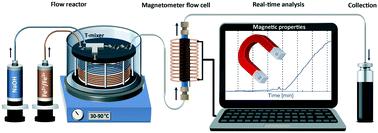Our official English website, www.x-mol.net, welcomes your feedback! (Note: you will need to create a separate account there.)
Development of an in-line magnetometer for flow chemistry and its demonstration for magnetic nanoparticle synthesis
Lab on a Chip ( IF 6.1 ) Pub Date : 2021-08-18 , DOI: 10.1039/d1lc00425e Maximilian O Besenhard 1 , Dai Jiang 2 , Quentin A Pankhurst 3 , Paul Southern 3 , Spyridon Damilos 1 , Liudmyla Storozhuk 3 , Andreas Demosthenous 2 , Nguyen T K Thanh 3, 4, 5 , Peter Dobson 6 , Asterios Gavriilidis 1
Lab on a Chip ( IF 6.1 ) Pub Date : 2021-08-18 , DOI: 10.1039/d1lc00425e Maximilian O Besenhard 1 , Dai Jiang 2 , Quentin A Pankhurst 3 , Paul Southern 3 , Spyridon Damilos 1 , Liudmyla Storozhuk 3 , Andreas Demosthenous 2 , Nguyen T K Thanh 3, 4, 5 , Peter Dobson 6 , Asterios Gavriilidis 1
Affiliation

|
Despite the wide usage of magnetic nanoparticles, it remains challenging to synthesise particles with properties that exploit each application's full potential. Time consuming experimental procedures and particle analysis hinder process development, which is commonly constrained to a handful of experiments without considering particle formation kinetics, reproducibility and scalability. Flow reactors are known for their potential of large-scale production and high-throughput screening of process parameters. These advantages, however, have not been utilised for magnetic nanoparticle synthesis where particle characterisation is performed, with a few exceptions, post-synthesis. To overcome this bottleneck, we developed a highly sensitive magnetometer for flow reactors to characterise magnetic nanoparticles in solution in-line and in real-time using alternating current susceptometry. This flow magnetometer enriches the flow-chemistry toolbox by facilitating continuous quality control and high-throughput screening of magnetic nanoparticle syntheses. The sensitivity required to monitor magnetic nanoparticle syntheses at the typically low concentrations (<100 mM of Fe) was achieved by comparing the signals induced in the sample and reference cell, each of which contained near-identical pairs of induction and pick-up coils. The reference cell was filled only with air, whereas the sample cell was a flow cell allowing sample solution to pass through. Balancing the flow and reference cell impedance with a newly developed electronic circuit was pivotal for the magnetometer's sensitivity. To showcase its potential, the flow magnetometer was used to monitor two iron oxide nanoparticle syntheses with well-known particle formation kinetics, i.e., co-precipitation syntheses with sodium carbonate and sodium hydroxide as base, which have been previously studied via synchrotron X-ray diffraction. The flow magnetometer facilitated batch (on-line) and flow (in-line) synthesis monitoring, providing new insights into the particle formation kinetics as well as, effect of temperature and pH. The compact lab-scale flow device presented here, opens up new possibilities for magnetic nanoparticle synthesis and manufacturing, including 1) early stage reaction characterisation 2) process monitoring and control and 3) high-throughput screening in combination with flow reactors.
中文翻译:

用于流动化学的在线磁力计的开发及其磁性纳米粒子合成的演示
尽管磁性纳米粒子被广泛使用,但合成具有充分发挥每个应用潜力的特性的粒子仍然具有挑战性。耗时的实验程序和颗粒分析阻碍了工艺开发,这通常仅限于少数实验,而没有考虑颗粒形成动力学、再现性和可扩展性。流动反应器以其大规模生产和高通量筛选工艺参数的潜力而闻名。然而,除了少数例外,在合成后进行磁性纳米颗粒合成时,这些优势并未被利用。为了克服这个瓶颈,我们开发了一种用于流动反应器的高灵敏度磁力计,以使用交流电磁化计在线和实时表征溶液中的磁性纳米粒子。该流动磁力计通过促进磁性纳米颗粒合成的连续质量控制和高通量筛选,丰富了流动化学工具箱。通过比较样品池和参考池中感应的信号来实现在典型低浓度(<100 mM Fe)下监测磁性纳米颗粒合成所需的灵敏度,每个池都包含几乎相同的感应线圈和拾波线圈对。参比池仅充满空气,而样品池是允许样品溶液通过的流动池。使用新开发的电子电路平衡流量和参考细胞阻抗对于磁力计的灵敏度至关重要。为了展示其潜力,流动磁力计用于监测具有众所周知的颗粒形成动力学的两种氧化铁纳米颗粒合成,即,以碳酸钠和氢氧化钠为碱的共沉淀合成,之前已通过同步加速器 X 射线衍射对其进行了研究。流动磁力计促进了批量(在线)和流动(在线)合成监测,为粒子形成动力学以及温度和 pH 值的影响提供了新的见解。此处介绍的紧凑型实验室规模流动装置为磁性纳米粒子的合成和制造开辟了新的可能性,包括 1) 早期反应表征 2) 过程监测和控制以及 3) 与流动反应器相结合的高通量筛选。
更新日期:2021-08-19
中文翻译:

用于流动化学的在线磁力计的开发及其磁性纳米粒子合成的演示
尽管磁性纳米粒子被广泛使用,但合成具有充分发挥每个应用潜力的特性的粒子仍然具有挑战性。耗时的实验程序和颗粒分析阻碍了工艺开发,这通常仅限于少数实验,而没有考虑颗粒形成动力学、再现性和可扩展性。流动反应器以其大规模生产和高通量筛选工艺参数的潜力而闻名。然而,除了少数例外,在合成后进行磁性纳米颗粒合成时,这些优势并未被利用。为了克服这个瓶颈,我们开发了一种用于流动反应器的高灵敏度磁力计,以使用交流电磁化计在线和实时表征溶液中的磁性纳米粒子。该流动磁力计通过促进磁性纳米颗粒合成的连续质量控制和高通量筛选,丰富了流动化学工具箱。通过比较样品池和参考池中感应的信号来实现在典型低浓度(<100 mM Fe)下监测磁性纳米颗粒合成所需的灵敏度,每个池都包含几乎相同的感应线圈和拾波线圈对。参比池仅充满空气,而样品池是允许样品溶液通过的流动池。使用新开发的电子电路平衡流量和参考细胞阻抗对于磁力计的灵敏度至关重要。为了展示其潜力,流动磁力计用于监测具有众所周知的颗粒形成动力学的两种氧化铁纳米颗粒合成,即,以碳酸钠和氢氧化钠为碱的共沉淀合成,之前已通过同步加速器 X 射线衍射对其进行了研究。流动磁力计促进了批量(在线)和流动(在线)合成监测,为粒子形成动力学以及温度和 pH 值的影响提供了新的见解。此处介绍的紧凑型实验室规模流动装置为磁性纳米粒子的合成和制造开辟了新的可能性,包括 1) 早期反应表征 2) 过程监测和控制以及 3) 与流动反应器相结合的高通量筛选。

























 京公网安备 11010802027423号
京公网安备 11010802027423号